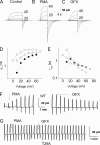Identification of Thr29 as a critical phosphorylation site that activates the human proton channel Hvcn1 in leukocytes
- PMID: 20037153
- PMCID: PMC2820736
- DOI: 10.1074/jbc.C109.082727
Identification of Thr29 as a critical phosphorylation site that activates the human proton channel Hvcn1 in leukocytes
Abstract
Voltage-gated proton channels and NADPH oxidase function cooperatively in phagocytes during the respiratory burst, when reactive oxygen species are produced to kill microbial invaders. Agents that activate NADPH oxidase also enhance proton channel gating profoundly, facilitating its roles in charge compensation and pH(i) regulation. The "enhanced gating mode" appears to reflect protein kinase C (PKC) phosphorylation. Here we examine two candidates for PKC-delta phosphorylation sites in the human voltage-gated proton channel, H(V)1 (Hvcn1), Thr(29) and Ser(97), both in the intracellular N terminus. Channel phosphorylation was reduced in single mutants S97A or T29A, and further in the double mutant T29A/S97A, by an in vitro kinase assay with PKC-delta. Enhanced gating was evaluated by expressing wild-type (WT) or mutant H(V)1 channels in LK35.2 cells, a B cell hybridoma. Stimulation by phorbol myristate acetate enhanced WT channel gating, and this effect was reversed by treatment with the PKC inhibitor GF109203X. The single mutant T29A or double mutant T29A/S97A failed to respond to phorbol myristate acetate or GF109203X. In contrast, the S97A mutant responded like cells transfected with WT H(V)1. We conclude that under these conditions, direct phosphorylation of the proton channel molecule at Thr(29) is primarily responsible for the enhancement of proton channel gating. This phosphorylation is crucial to activation of the proton conductance during the respiratory burst in phagocytes.
Figures


Similar articles
-
Sustained activation of proton channels and NADPH oxidase in human eosinophils and murine granulocytes requires PKC but not cPLA2 alpha activity.J Physiol. 2007 Mar 1;579(Pt 2):327-44. doi: 10.1113/jphysiol.2006.124248. Epub 2006 Dec 21. J Physiol. 2007. PMID: 17185330 Free PMC article.
-
Proton channel HVCN1 is required for effector functions of mouse eosinophils.BMC Immunol. 2013 May 24;14:24. doi: 10.1186/1471-2172-14-24. BMC Immunol. 2013. PMID: 23705768 Free PMC article.
-
The gp91phox component of NADPH oxidase is not the voltage-gated proton channel in phagocytes, but it helps.J Biol Chem. 2001 Sep 28;276(39):36063-6. doi: 10.1074/jbc.C100352200. Epub 2001 Jul 26. J Biol Chem. 2001. PMID: 11477065
-
Pharmacology of voltage-gated proton channels.Curr Pharm Des. 2007;13(23):2400-20. doi: 10.2174/138161207781368675. Curr Pharm Des. 2007. PMID: 17692009 Review.
-
Voltage-gated proton channels find their dream job managing the respiratory burst in phagocytes.Physiology (Bethesda). 2010 Feb;25(1):27-40. doi: 10.1152/physiol.00039.2009. Physiology (Bethesda). 2010. PMID: 20134026 Free PMC article. Review.
Cited by
-
New insights into the regulation of neutrophil NADPH oxidase activity in the phagosome: a focus on the role of lipid and Ca(2+) signaling.Antioxid Redox Signal. 2013 Feb 20;18(6):661-76. doi: 10.1089/ars.2012.4773. Epub 2012 Sep 18. Antioxid Redox Signal. 2013. PMID: 22867131 Free PMC article. Review.
-
Insights into the structure and function of HV1 from a meta-analysis of mutation studies.J Gen Physiol. 2016 Aug;148(2):97-118. doi: 10.1085/jgp.201611619. J Gen Physiol. 2016. PMID: 27481712 Free PMC article. Review.
-
The Voltage-Gated Proton Channel: A Riddle, Wrapped in a Mystery, inside an Enigma.Biochemistry. 2015 Jun 2;54(21):3250-68. doi: 10.1021/acs.biochem.5b00353. Epub 2015 May 20. Biochemistry. 2015. PMID: 25964989 Free PMC article. Review.
-
Voltage and pH sensing by the voltage-gated proton channel, HV1.J R Soc Interface. 2018 Apr;15(141):20180108. doi: 10.1098/rsif.2018.0108. J R Soc Interface. 2018. PMID: 29643227 Free PMC article. Review.
-
Oligomerization of the voltage-gated proton channel.Channels (Austin). 2010 Jul-Aug;4(4):260-5. doi: 10.4161/chan.4.4.12789. Epub 2010 Jul 24. Channels (Austin). 2010. PMID: 20676047 Free PMC article.
References
Publication types
MeSH terms
Substances
Grants and funding
LinkOut - more resources
Full Text Sources
Molecular Biology Databases

